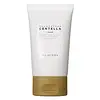What's inside
What's inside
 Key Ingredients
Key Ingredients

 Benefits
Benefits

 Concerns
Concerns

 Ingredients Side-by-side
Ingredients Side-by-side

Water
Skin ConditioningSea Water
HumectantPropylene Glycol
HumectantButylene Glycol
HumectantEthoxydiglycol
HumectantAmmonium Acryloyldimethyltaurate/Vp Copolymer
Phenoxyethanol
PreservativeSalicylic Acid
MaskingMaltooligosyl Glucoside
Skin ConditioningHydrogenated Starch Hydrolysate
HumectantXanthan Gum
EmulsifyingSodium Hydroxide
BufferingCaprylyl Glycol
EmollientChlorphenesin
AntimicrobialDisodium EDTA
Aloe Barbadensis Leaf Juice
Skin ConditioningMaltodextrin
AbsorbentCeramide AP
Skin Conditioning1,10-Decanediol
Solvent10-Hydroxydecanoic Acid
Skin ConditioningSebacic Acid
BufferingWater, Sea Water, Propylene Glycol, Butylene Glycol, Ethoxydiglycol, Ammonium Acryloyldimethyltaurate/Vp Copolymer, Phenoxyethanol, Salicylic Acid, Maltooligosyl Glucoside, Hydrogenated Starch Hydrolysate, Xanthan Gum, Sodium Hydroxide, Caprylyl Glycol, Chlorphenesin, Disodium EDTA, Aloe Barbadensis Leaf Juice, Maltodextrin, Ceramide AP, 1,10-Decanediol, 10-Hydroxydecanoic Acid, Sebacic Acid
Cetyl Ethylhexanoate
EmollientGlycerin
HumectantPentylene Glycol
Skin ConditioningHydrogenated Lecithin
EmulsifyingNiacinamide
SmoothingMacadamia Ternifolia Seed Oil
EmollientPEG-50 Shea Butter
EmulsifyingLimnanthes Alba Seed Oil
Skin ConditioningSqualane
EmollientCarbomer
Emulsion Stabilising1,2-Hexanediol
Skin ConditioningTromethamine
BufferingPanthenol
Skin ConditioningSodium Carbomer
Emulsion StabilisingErythritol
HumectantTrehalose
HumectantBetaine
HumectantButylene Glycol
HumectantCaprylhydroxamic Acid
Caprylic/Capric Triglyceride
MaskingAdenosine
Skin ConditioningLavandula Spica Flower Oil
MaskingXanthan Gum
EmulsifyingOzonized Olive Oil
Skin ConditioningHydroxyethylcellulose
Emulsion StabilisingOrange Roughy Oil
Skin ConditioningMadecassoside
AntioxidantBiosaccharide Gum-1
HumectantAsiaticoside
AntioxidantMalt Extract
Skin ProtectingAsiatic Acid
Skin ConditioningButter Extract
EmollientGlycyrrhiza Glabra Leaf Extract
Skin ConditioningCeramide AP
Skin ConditioningChamomilla Recutita Flower Extract
MaskingLinoleic Acid
CleansingEthylhexylglycerin
Skin ConditioningSodium Hyaluronate
HumectantLinolenic Acid
CleansingCetyl Ethylhexanoate, Glycerin, Pentylene Glycol, Hydrogenated Lecithin, Niacinamide, Macadamia Ternifolia Seed Oil, PEG-50 Shea Butter, Limnanthes Alba Seed Oil, Squalane, Carbomer, 1,2-Hexanediol, Tromethamine, Panthenol, Sodium Carbomer, Erythritol, Trehalose, Betaine, Butylene Glycol, Caprylhydroxamic Acid, Caprylic/Capric Triglyceride, Adenosine, Lavandula Spica Flower Oil, Xanthan Gum, Ozonized Olive Oil, Hydroxyethylcellulose, Orange Roughy Oil, Madecassoside, Biosaccharide Gum-1, Asiaticoside, Malt Extract, Asiatic Acid, Butter Extract, Glycyrrhiza Glabra Leaf Extract, Ceramide AP, Chamomilla Recutita Flower Extract, Linoleic Acid, Ethylhexylglycerin, Sodium Hyaluronate, Linolenic Acid
 Reviews
Reviews

Ingredients Explained
These ingredients are found in both products.
Ingredients higher up in an ingredient list are typically present in a larger amount.
Butylene Glycol (or BG) is used within cosmetic products for a few different reasons:
Overall, Butylene Glycol is a safe and well-rounded ingredient that works well with other ingredients.
Though this ingredient works well with most skin types, some people with sensitive skin may experience a reaction such as allergic rashes, closed comedones, or itchiness.
Learn more about Butylene GlycolCeramide AP is a type of Ceramide.
Ceramides are intercellular lipids naturally found in our skin that bonds dead skin cells together to create a barrier. Having a strong skin barrier leads to more firm and hydrated skin.
They are known for their ability to hold water and thus are a great ingredient for dry skin. By bolstering the skin ceramides act as a barrier against irritating ingredients. This can help with inflammation as well.
If you would like to eat ceramides, sweet potatoes contain a small amount.
Read more about other common types of ceramides here:
Ceramide NP
Ceramide EOP
Xanthan gum is used as a stabilizer and thickener within cosmetic products. It helps give products a sticky, thick feeling - preventing them from being too runny.
On the technical side of things, xanthan gum is a polysaccharide - a combination consisting of multiple sugar molecules bonded together.
Xanthan gum is a pretty common and great ingredient. It is a natural, non-toxic, non-irritating ingredient that is also commonly used in food products.
Learn more about Xanthan Gum